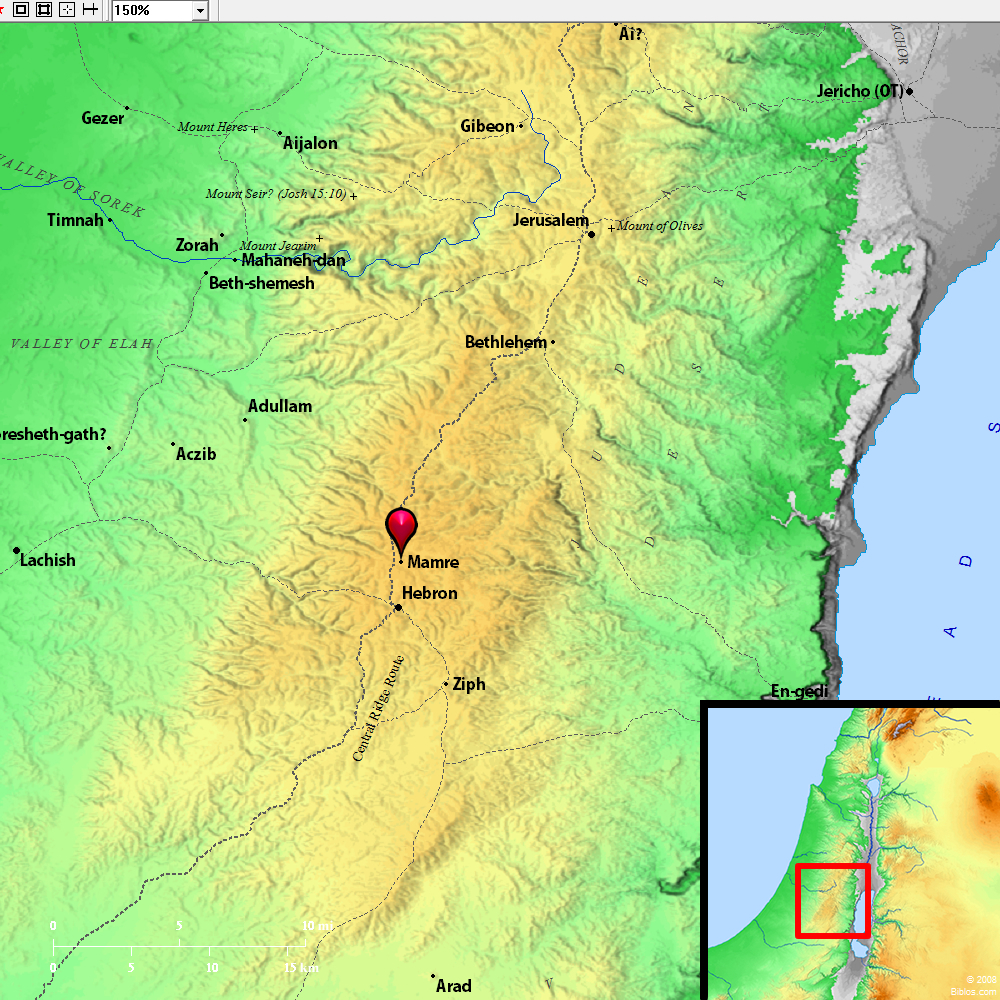Atlas

Valley of Hebron (Mamre) and surrounding region
Maps Created using Biblemapper 3.0Additional data from OpenBible.infoOccurrences
Genesis 37:14 He said to him, "Go now, see whether it is well with your brothers, and well with the flock; and bring me word again." So he sent him out of the valley of Hebron, and he came to Shechem.
Encyclopedia
MAMREmam'-re (mamre'; Septuagint Mambre):
(1) In Genesis 14:24 Mamre is mentioned as the name of one of Abraham's allies, who in 14:13 is described as the Amorite, brother of Eschcol and Aner.
1. Biblical Data:
The name of the grove of trees is evidently considered as derived from this sheikh or chieftain. The "oaks" ("terebinths") of Mamre where Abram pitched his tent (Genesis 14:13; Genesis 18:1) are described (Genesis 13:18) as "in Hebron." Later on MACHPELAH (which see) is described as "before," i.e. "to the East of Mamre" (Genesis 23:17; Genesis 25:9; Genesis 49:30; Genesis 50:13), and Mamre is identified with Hebron itself (Genesis 23:19).
2. Traditional Sites:
While Mamre has always been looked for in the vicinity of Hebron, the traditions have varied greatly, determined apparently by the presence of a suitable tree. The one site which has a claim on grounds other than tradition is that called Khirbet and `Ain Nimreh (literally, the "ruin" and "spring" of "the leopard"), about 1/2 mile North-Northwest of modern Hebron. The word Nimreh may be a survival of the ancient Mamre, the name, as often happens, being assimilated by a familiar word. The site is a possible one, but, beyond this, the name has not much to commend it.
Tradition has centered round three different sites at various periods:
(1) The modern tradition points to a magnificent oak (Quercus ilex, Arabic Sindian), 1 1/2 miles West-Northwest of the modern city, as the terebinth of Abraham; its trunk has a girth of 32 ft. It is now in a dying condition, but when Robinson visited it (BR, II, 72, 81) it was in fine condition; he mentions a Mohammedan tradition that this was "Abraham's oak." Since then the site had been bought by the Russians, a hospice and church have been erected, and the tradition, though of no antiquity, has become crystallized.
(2) The second tradition, which flourished from the 16th century down to the commencement of the 19th century, pointed to the hill of Deir el Arba`in (see HEBRON) as that of Mamre, relying especially, no doubt, in its inception on the identity of Mamre and Hebron (Genesis 23:19). A magnificent terebinth which stood there was pointed out as that of Abraham. The site agrees well with the statement that the cave of Machpelah was "before," i.e. to the East of Mamre (Genesis 23:17, etc.).
(3) The third and much older tradition, mentioned in several Christian writers, refers to a great terebinth which once stood in an enclosure some 2 miles North of Hebron, near the road to Jerusalem. It is practically certain that the site of this enclosure is the strange Ramet el-Khalil. This is an enclosure some 214 ft. long and 162 ft. wide. The enclosing walls are made of extremely fine and massive masonry and are 6 ft. thick; the stones are very well laid and the jointing is very fine, but the building was evidently never completed. In one corner is a well-Bir el-Khalil-lined with beautiful ashlar masonry, cut to the curve of the circumference.
It is probable that this enclosure surrounded a magnificent terebinth; if so, it was at this spot that before the days of Constantine a great annual fair was held, attended by Jews, Christians and heathen who united a pay honor to the sacred tree, while the well was on the same occasion illuminated, and offerings were made to it. Similar customs survive today at several shrines in Palestine. Constantine suppressed these "superstitions," and built a church in the neighborhood, probably the so-called "Abraham's house," Beit Ibrahim of today. The tree which stood here is apparently that mentioned by Josephus (BJ, IV, ix, 7) as having continued "since the creation of the world." At this enclosure, too, Jewish women and children were sold at auction after the suppression of the revolt of Bar Cochba. Whatever the origin of the veneration paid to this terebinth-now long centuries dead and gone-early Christian tradition associated it with Abraham and located Mamre here. This tradition is mentioned by Jerome (4th century), by Eucherius (6th century), by Areulphus (700 A.D.) and by Benjamin of Tudela (1163 A.D.). Among the modern Jews it is looked upon as the site of "Abraham's oak." It is probable that the view that Abraham was connected with this tree is one attached to it much later than its original sanctity; it was originally one of the many "holy trees" of the land venerated by primitive Semitic religions feeling, and the nearness of Hebron caused the Bible story to be attached to it. Judging from the Bible data, it appears to be too far from Hebron and Machpelah to suit the conditions; the site of Mamre must have been nearer to Deir el Arba`in, but it has probably been entirely lost since very early times.
For a very good discussion about Mamre see Mambre by Le R. P. Abel des Freres Precheurs in the Conferences de Saint Etienne, 1909-10 (Paris).
(2) An Amorite chief, owner of the "oaks" mentioned above (Genesis 14:13, 14).
E. W. G. Masterman




